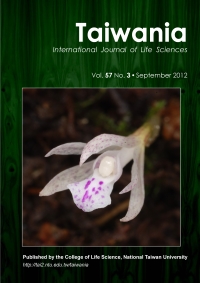Research Paper
Forest Distribution on Small Isolated Hills and Implications on Woody Plant Distribution under Threats of Global Warming
Chi-Cheng Liao, Shih-Chieh Kuo and Chi-Ru Chang
Published on: 13 September 2012
Page: 242 - 250
DOI: 10.6165/tai.2012.57(3).242
Abstract
Treelines have been found to be lower in small isolated hilltops, but the specific dynamics behind this unique phenomenon are unknown. This study investigates the distribution patterns of woody plants in Yangmingshan National Park (YMSNP), Northern Taiwan in search of the limitation mechanisms unique to small isolated hills, and to evaluate potential threats under global warming. Forests distributed between 200 to 900 m above sea level (ASL). Remnant forest fragments between 400 and 900 m ASL, have the highest species richness, and should be protected to ensure future forest recovery from the former extensive artificial disturbance. The lower boundary is threatened by urban and agricultural development. The lack of native woody species in these low elevation zones may cause a gap susceptible to invasive species. A consistent forest line at 100 m below mountain tops regardless of elevation suggests a topography-induced instead of an elevation-related limiting mechanism. Therefore, upward-shift of forests, caused by global warming, might be limited at 100 m below hilltops in small isolated hills because of topography-related factors. The spatial range of woody plants along the altitudinal gradient, thus, is likely to become narrower under the combined pressures of global warming, limited elevation, exposure-related stress, and artificial disturbance. Management priorities for forest recovery are suggested to include preservation of remnant forest fragments, increasing forest connectivity, and increasing seedling establishment in the grasslands.
中文摘要
造成獨立低山丘陵形成森林界限的原因並不清楚,對於木本植物在全球變遷壓力下所受到的威脅也沒有相關研究的探討。本研究主要在瞭解獨立低山丘陵的木本植物分布,推測森林界限形成的原因,並評估全球變遷下木本植物所受到的威脅。陽明山國家公園是位在台灣北部獨立的低山丘陵,此地區的森林主要分布在海拔200至900公尺之間,殘存較大面積的森林介於海拔400至900公尺之間,需要積極的保護,維持物種多樣性,使得森林能夠由過去的大面積人為干擾之後進行復育,並保證有充分的種源。國家公園低海拔地區由於長久的都市發展及開拓墾殖,木本植物種類多樣性相當低,使得此地區受到外來種入侵的可能性相對增高;較高海拔的部分,山頂或稜綫的下方100公尺處常會出現森林界限,可見木本植物的分布受到地形因子的影響,而非海拔。因此,全球溫度上升造成木本植物遷移的過程,在獨立低山丘陵會受到地形效應的影響而非溫度,並且植物往高海拔遷移的過程可能會被限制在稜綫下方約100公尺處。因此,低山丘陵的植物分布,在人為干擾、海拔限制、地形效應及全球變遷的多重影響下,海拔分布範圍將會受到壓縮。因此低山丘陵的森林復育過程,需要優先考量保育現有的原生森林、增加殘存森林之間的連結、增加木本植物小苗在草原上建立的可能性。
Keyword: Altitudinal gradient, forest line, global warming, species richness, Yangmingshan National Park.


